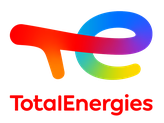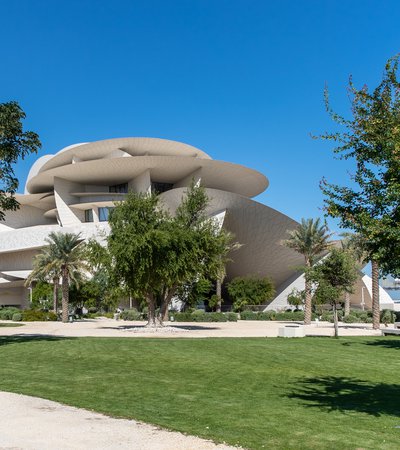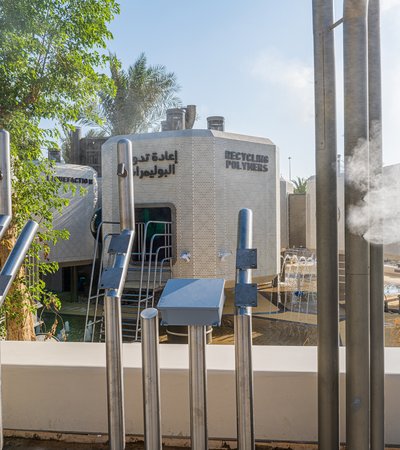Overview of the Playground
Pod 1: The Natural Source Zone
Underground reserves are made from fossils, evidencing past life on earth.
In the Natural Source area, children can explore the areas where oil and gas has been extracted in Qatar.
Pod 2: Extraction
Oil and natural gas are extracted from the earth by drilling into the ground.
Using levers and their own strength, children work as a team to pump a flow of water from the pipes and machinery.
Pod 3: Storage & Transport
Oil and natural gas are transported in huge pipelines and tankers before being pumped into the processing plant for the refinery process.
The water from the extraction pod flows in through the connecting pipe, linking one process point to the next and encouraging children to touch and feel.
Pod 4: Processing Plant
Using different temperatures, crude oil is separated into different products.
The processing plant is the hub of the playground, the central point where children can choose different pathways and discover various energy journeys.
Pod 5: Molecular Changes
The heavy molecules are cracked to create petroleum products such as gas, gasoline and diesel.
In this pod, children will be amazed by a large-scale marble run, in which each marble represents a molecule traveling through a network of pipes.
Pod 6: Engine Oil
Engine oil is processed and used to keep engines lubricated and safe.
A woven, soft network of oil-like ‘drips’ creates an immersive experience that invites children to crawl through the space.
Pod 7: Asphalt
Asphalt is a sticky, black petroleum product used on the roads we drive through every day.
Children’s imaginations come alive as they become the cars navigating a network of roads created with asphalt and held together with bitumen.
Pod 8: Fuels
Engine fuel is a product of crude oil, which powers diesel and petrol engines like those used by cars, trucks, buses and other vehicles.
In this pod, children work together to make an engine move by rotating camshafts, creating a colourful and dynamic display.
Pod 9: Carbon Capture
Carbon dioxide produced by industrial processes can be captured and stored or reused to help fight global warming.
Two different interactive features in this pod allow children to play a game that shows how we can balance the carbon cycle to mitigate global warming, and to learn about the benefits of trees in our environments.
Pod 10: Renewable Energy
Energy is considered renewable when it comes from a source that can be easily reproduced by nature.
Solar, wind power and other technologies represent the world’s future renewable energy. This pod invites children to simulate turning wind turbines and flipping solar panels to face the sun, to demonstrate how future cities will be powered.
This pod also features information about the energy generated by its own solar panels and wind turbines.
Pod 11: LPG
Liquefied Petroleum Gas (LPG) is a mixture of hydrocarbon gas and is mainly used for cooking and heating processes.
Here, children learn about Liquified Petroleum Gas (LPG), and they can role play cooking using a range of tools, and sharing food with family and friends.
Pod 12: Liquefaction
Through a process of compression and cooling, gas is transformed into a liquid to be stored or transported.
Compressing and cooling gas allows for its safe storage and transportation. Through teamwork, children in this pod pump a large central plunger to simulate the transformation from gas into a liquid state.
Pod 13: LNG Heating and Cooling
Liquefied Natural Gas (LNG) is used to generate power and can also be used as an alternative to fuel.
In this pod children are reminded, through play opportunities, that natural gas and refined oil is what powers heating and cooling systems in homes and other buildings.
Pod 14: Cracker
Hydrocarbons from the refinery are heated under high pressure until they split into smaller components.
Children climb through holes in the internal walls of this pod, from a simple network to a more complex one referencing the cracking of hydrocarbon molecules.
Pod 15: Recycling Polymers
To preserve the environment, the best solution is to recycle used plastics to bring them back into the life cycle.
Finally, in the last pod, children interact with recycling “bins” that highlight the processes of end products created from the recycling of plastics, glass, paper and aluminium.
Clearly, this is no ordinary playground! There is so much to explore that visitors will enjoy coming again and again.


